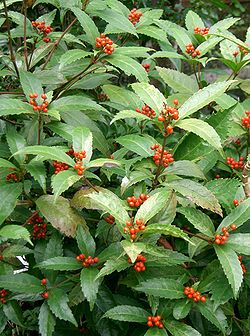Top Qs
Timeline
Chat
Perspective
Sarcandra glabra
Species of herb From Wikipedia, the free encyclopedia
Remove ads
Sarcandra glabra is a herb native to Southeast Asia. It is also known as herba sarcandrae or glabrous sarcandra herb. Other common names include the nine-knotted flower and the bone-knitted lotus.[2]
You can help expand this article with text translated from the corresponding article in Chinese. (March 2015) Click [show] for important translation instructions.
|
Aromatic oils may be extracted from the leaves. This extract has been shown in mice to reduce immunologic attenuation due to stress.[3]
Remove ads
Morphology
This article may be confusing or unclear to readers. (June 2022) |
Leaf blade elliptic or ovate-lanceolate, 6–17 × 2–6 cm, leathery, margin sharply coarsely-serrate. Stamen baculate to terete; thecae shorter than connective. Stigma subcapitate. Fruit globose or ovoid, 3–4 mm in diam.[4]
Distribution
This section needs additional citations for verification. (September 2025) |

The plant is distributed in Vietnam, Sri Lanka, Taiwan, Cambodia, Malaysia, India, Japan, Korea, the Philippines, and in China (Jiangxi, Anhui, Fujian, Guizhou, Guangxi, Hong Kong, Hunan, Sichuan, Yunnan, Guangdong, Zhejiang and other places),[5] growing at an altitude of 420 meters to 1,500 meters, often growing on wet slopes and in shaded valleys.
Remove ads
Use in Japanese culture
The plant is used during Japanese New Year for chabana decoration, normally along winter jasmine.[6][7] Others plants used instead of Sarcandra glabra because of its similarity to it are coralberry trees and Ardisia japonica.[6]
References
Wikiwand - on
Seamless Wikipedia browsing. On steroids.
Remove ads

